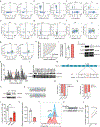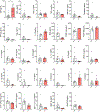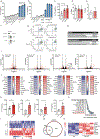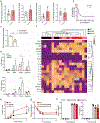Human autoinflammatory disease reveals ELF4 as a transcriptional regulator of inflammation
- PMID: 34326534
- PMCID: PMC8985851
- DOI: 10.1038/s41590-021-00984-4
Human autoinflammatory disease reveals ELF4 as a transcriptional regulator of inflammation
Abstract
Transcription factors specialized to limit the destructive potential of inflammatory immune cells remain ill-defined. We discovered loss-of-function variants in the X-linked ETS transcription factor gene ELF4 in multiple unrelated male patients with early onset mucosal autoinflammation and inflammatory bowel disease (IBD) characteristics, including fevers and ulcers that responded to interleukin-1 (IL-1), tumor necrosis factor or IL-12p40 blockade. Using cells from patients and newly generated mouse models, we uncovered ELF4-mutant macrophages having hyperinflammatory responses to a range of innate stimuli. In mouse macrophages, Elf4 both sustained the expression of anti-inflammatory genes, such as Il1rn, and limited the upregulation of inflammation amplifiers, including S100A8, Lcn2, Trem1 and neutrophil chemoattractants. Blockade of Trem1 reversed inflammation and intestine pathology after in vivo lipopolysaccharide challenge in mice carrying patient-derived variants in Elf4. Thus, ELF4 restrains inflammation and protects against mucosal disease, a discovery with broad translational relevance for human inflammatory disorders such as IBD.
© 2021. The Author(s), under exclusive licence to Springer Nature America, Inc.
Conflict of interest statement
Figures










References
Publication types
MeSH terms
Substances
Grants and funding
LinkOut - more resources
Full Text Sources
Molecular Biology Databases
Miscellaneous

